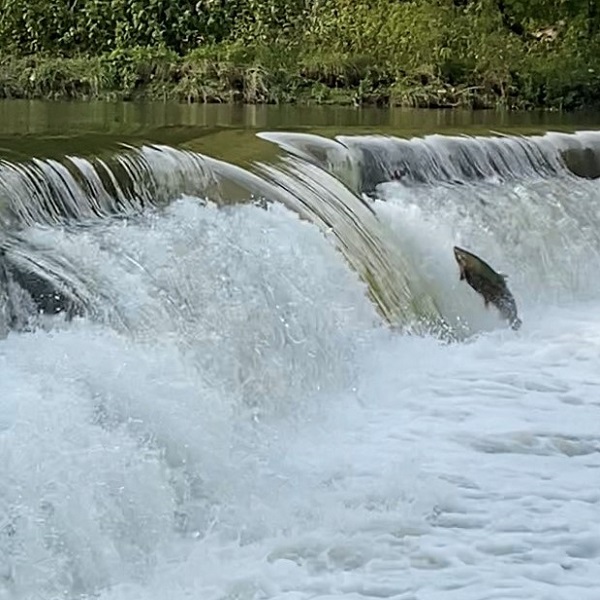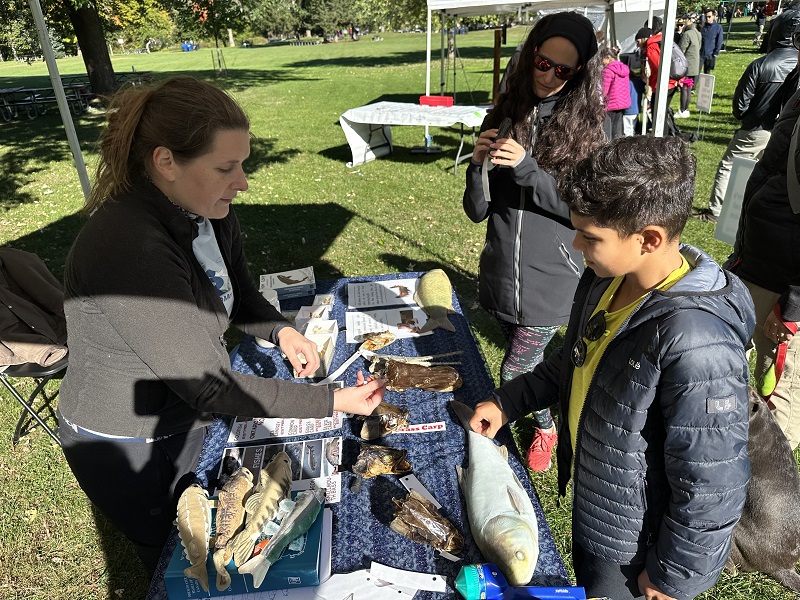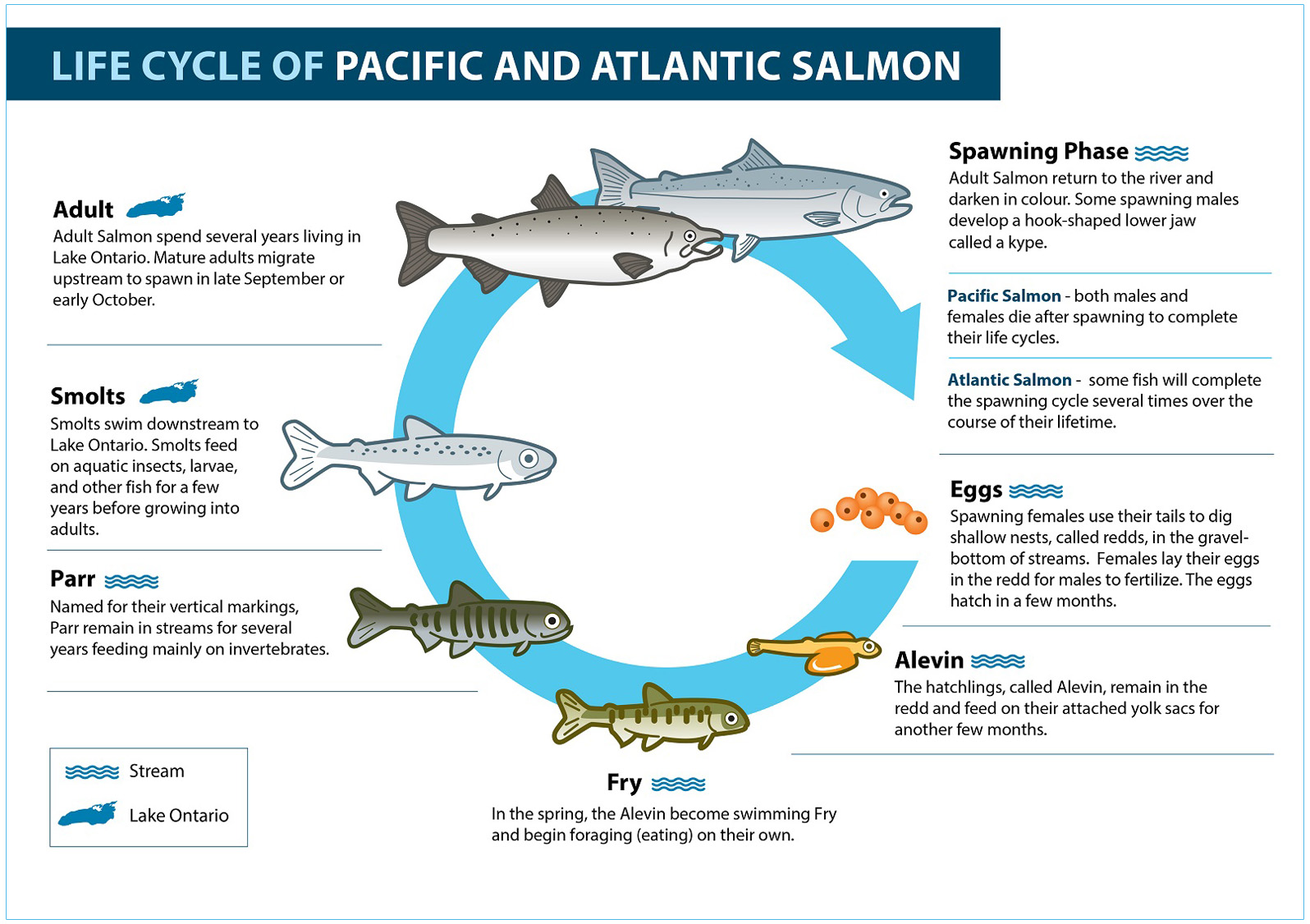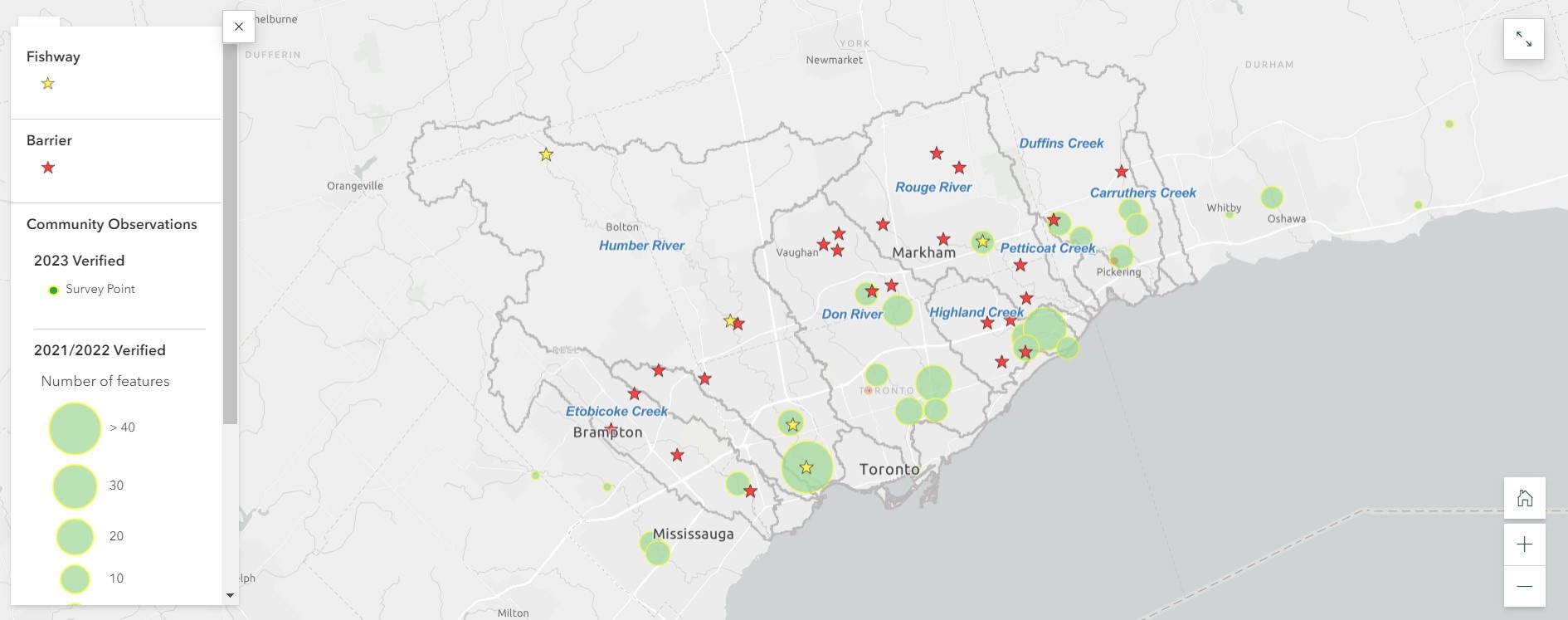Every fall, the salmon in Toronto Region’s waters embark on an extraordinary adventure – one that exemplifies of the intricate web of life thriving within our local ecosystems.
Toronto and Region Conservation Authority (TRCA) ensures the vitality of these fascinating fish through research, monitoring of fish communities, and restoration of aquatic habitat.
TRCA collects long-term monitoring information about fish habitat and communities in regional rivers, wetlands, and along the Lake Ontario shoreline, using backpack and boat electrofishing surveys.

This data is a powerful tool, revealing the overall health of native fish communities.
Additionally, TRCA’s restoration efforts, guided by the Toronto and Region Remedial Action Plan, have been instrumental in restoring local fish habitat, revitalizing the aquatic ecosystem, and ensuring a brighter future for Toronto area waters.
Introducing our Local Salmon Species
Lake Ontario and its tributaries are home to several fascinating fall spawning Salmonid species such as Chinook, Coho and Atlantic Salmon, as well as Brown Trout.
These remarkable fish play a vital role as top predators, helping to maintain the delicate balance of smaller fish populations.




A century ago, the majestic Atlantic Salmon’s population become locally extinct due to deforestation, pollution, and the construction of dams and weirs.
Thanks to initiatives such as the Lake Ontario Atlantic Salmon Restoration Program, these native fish are making a welcome comeback.
Chinook Salmon, a Pacific Salmon species, is now the most common Salmonid found migrating upstream in Toronto Region streams.
Chinook Salmon were introduced in the late 1800s to enhance recreational fishing. Today they are a familiar sight in local waters.
The silvery Coho Salmon, also a Pacific species, are similar to Chinook Salmon but smaller in size, and less commonly found in regional streams and rivers.
Originating in Europe, Brown Trout were introduced into Lake Ontario in the late 19th century. Like the Chinook Salmon, they arrived here as part of an effort to create more recreational fishing opportunities.
Over the years, Brown Trout have become an iconic presence, attracting anglers and nature enthusiasts, and helping to enrich the biodiversity of our waters.
The Annual Salmon Migration
As fall approaches, a breathtaking natural phenomenon takes centre stage: the famous salmon migration!
These resilient fish leave the chilly waters of Lake Ontario and navigate upstream through Toronto’s waterways to their spawning grounds. In the Humber River, Duffins Creek, and elsewhere, mature salmon breed to create the next generation.



Salmon spotted on the Humber River as they migrate to their spawning grounds upstream.
The mystery of how salmon find their way home remains a puzzle. Scientists believe they use a combination of magnetic fields and smell to navigate back to their birthplace.
Once they’ve found a suitable spot, females create nests called “redds” to lay their eggs.
Chinook and Coho Salmon, species known as “terminal spawners”, die after this process, the decay of their nutrient-rich bodies sustaining the ecosystem and creating a circle of life.
Atlantic Salmon, by contrast, can repeat this cycle multiple times before they die.
In Toronto’s waters, the spirit of salmon prevails as they overcome both natural and human-created obstacles to complete their life cycle.
With TRCA’s dedication and community involvement, the future looks promising for these remarkable aquatic travellers!
How to Get Involved and Learn About Local Salmon Conservation
Help TRCA monitor the migration of salmon by reporting any salmon sightings in local streams and rivers through our Salmon Reporting Tool.
This online platform features:
- Real-time Tracking: Stay updated with real-time information about salmon movement in Toronto’s rivers and streams. The tool provides valuable data about migration timing, locations, and progress. Gain a deeper appreciation for the challenges salmon face.
- Interactive Mapping: Immerse yourself in the journey with an interactive map showcasing locations where you can spot salmon.
- Community Engagement: Join a community united by a shared passion for conservation. Contribute observations, share insights, and learn from fellow enthusiasts, creating a stronger connection to nature.
- Educational Opportunities: Explore an educational platform suitable for all ages. Teachers can integrate the tool into lessons, helping students learn about ecology, biology, and the significance of preserving delicate ecosystems.
Select the thumbnail image below to view TRCA’s Salmon Reporting Tool.
Join Us at TRCA Adventures of Salmon
On Sunday, September 24, 2023, TRCA will host the annual Adventures of Salmon event at Morningside Park in Toronto from 10:00 a.m. to 4:00 p.m.



Visit our educational and interactive booths showcasing the adventures of salmon during their migration phase, the various species that live in our lakes and their life cycles, the work TRCA is doing to help them thrive in our waters, and much more!
Remember to keep your eyes peeled at the Adventures of Salmon event, and hopefully spot salmon as they jump upstream to spawn!
REGISTER NOW FOR THIS FREE EVENT
- Learn more about salmon in Toronto and GTA waters.
- View our Frequently Asked Questions about salmon migration.


